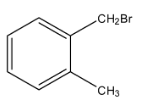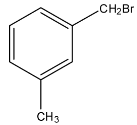
Compound (A),
a.

b.

c.

d.





Answer
450k+ views
Hint: In the question, the compound (A) can form a yellow precipitate with silver nitrate, this is due to the fact that there is the formation of silver bromide, this can be formed only when the bromine atom from the compound can be easily released, if the bromine atom is attached with the benzene ring then, it will not easily release.
Complete answer: In the question, the compound (A) can form a yellow precipitate with silver nitrate, this is due to the fact that there is the formation of silver bromide, this can be formed only when the bromine atom from the compound can be easily released, if the bromine atom is attached with the benzene ring then, it will not easily release.
So, from the given options, (a) is not correct.
The second part of the question says that oxidation forms acid and it can easily form the anhydride. An anhydride can be formed from the compound only if both the acid groups are very near. Therefore, from the given options, only option (c), can form the anhydride.
The reactions are given below:

So, from the reaction, we can see that a correct answer is an option (c).
Note: If the acids on the benzene ring are present on the meta and para positions then, the anhydride cannot be formed, and anhydride is formed when one molecule of water is removed from the acid.
Complete answer: In the question, the compound (A) can form a yellow precipitate with silver nitrate, this is due to the fact that there is the formation of silver bromide, this can be formed only when the bromine atom from the compound can be easily released, if the bromine atom is attached with the benzene ring then, it will not easily release.
So, from the given options, (a) is not correct.
The second part of the question says that oxidation forms acid and it can easily form the anhydride. An anhydride can be formed from the compound only if both the acid groups are very near. Therefore, from the given options, only option (c), can form the anhydride.
The reactions are given below:

So, from the reaction, we can see that a correct answer is an option (c).
Note: If the acids on the benzene ring are present on the meta and para positions then, the anhydride cannot be formed, and anhydride is formed when one molecule of water is removed from the acid.
Recently Updated Pages
Master Class 12 Business Studies: Engaging Questions & Answers for Success

Master Class 12 English: Engaging Questions & Answers for Success

Master Class 12 Social Science: Engaging Questions & Answers for Success

Master Class 12 Chemistry: Engaging Questions & Answers for Success

Class 12 Question and Answer - Your Ultimate Solutions Guide

Master Class 11 Economics: Engaging Questions & Answers for Success

Trending doubts
Draw a labelled sketch of the human eye class 12 physics CBSE

a Tabulate the differences in the characteristics of class 12 chemistry CBSE

Which one of the following is a true fish A Jellyfish class 12 biology CBSE

Why is the cell called the structural and functional class 12 biology CBSE

Differentiate between homogeneous and heterogeneous class 12 chemistry CBSE

Write the difference between solid liquid and gas class 12 chemistry CBSE




